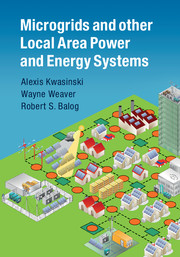6 - Energy storage
from Part II - Technologies
Published online by Cambridge University Press: 05 July 2016
Summary
This chapter discusses electrical energy storage technologies, management, and conversion requirements. Thus, the focus is not just oriented toward electrochemistry or physical analysis but rather how specific characteristics of each particular technology affect microgrid design, planning, and operation. There are fundamental differences between microgrids and traditional backup systems with respect to the requirements and choices for energy storage technology. In general, energy storage devices can be characterized by operation in two distinct modes: used often and in short intervals (i.e., a power delivery profile) or used seldom for long intervals (i.e., an energy delivery profile). Energy storage with a power-delivery profile is commonly needed in microgrids to compensate for slow dynamic response of some local generation sources, such as fuel cells. One example of using an energy storage device with an energy delivery profile is powering a load at night in a stand-alone photovoltaic system. In this chapter, batteries are considered as devices with energy delivery profiles, whereas ultracapacitors and flywheels are two storage technologies with power delivery profiles. Other storage technologies, such as pumped hydro, are not considered here because they tend to be dependent on location and thus are not universal options for arbitrarily located LAPES. The main battery technologies are compared by considering some important characteristics, such as scalability, cost, lifetime, and cycle-life. Charging circuits and energy management are also discussed. Particular energy conversion requirements, such as the need for a constant current, are also explored. In addition to explaining their basic physical characteristics and features, this chapter discusses suitable energy conversion interfaces.
Introduction
A basic operational requirement in a conventional power grid – thus, without energy storage devices – is that electricity generation and consumption must be continuously balanced. This requirement imposes difficult operational constraints on the system when variability on both the load side and source side exists, such as with renewable energy sources like wind and solar that are variable. Energy storage is an important concept to ensure that electricity is generated when the source is available, and that the load continues to be supplied when the source is not present or insufficient. Batteries can improve the electric power system asset utilization, energy availability, and performance.
Information
- Type
- Chapter
- Information
- Microgrids and other Local Area Power and Energy Systems , pp. 255 - 298Publisher: Cambridge University PressPrint publication year: 2016
